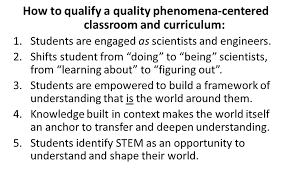Phenomena. Such a big word. And such an important concept that is often forgotten or left out of science teaching. Phenomena are simply things we observe around us. When we introduce phenomena to our students, we want them to investigate through observation. In the classroom, they are an important tool for ownership of STEM work. What we as educators want to steer away from is, to paraphrase Yeats, stop filling buckets and start to light fires.
We use phenomena to ask questions, observe, and predict. This way of beginning helps students understand why they are learning something without them even asking. They become active participants in their own learning; figuring things out instead of just finding out. Not just anything can be phenomena, we ned to make sure that the observations lead to connections with the standards we are working on.
And phenomena is the way. It is more than just a KWL chart and some discussion (though those are important!). When teachers begin with phenomena, we start conversations with our students. We hear misconceptions and knowledge without judgement. And by including student wonderings into our inquiry work, we light the fire of learning.

The glory of the Next Generation Science Standards is that they are not tied down. The Frameworks are laid out in such a way that educators can find their own way of teaching, and, as such, can imagine any way to bring them to life.
So how do we use this? It’s a simple engagement activity that you spend five or ten minutes on before you start a unit or even a lesson.
For this heat lesson, we simply rub our hands together for 30 seconds. It’s longer than you think! Students then begin to think of friction as a source of heat. You can continue by asking for questions that they have. You might hear some misconceptions, but now is not the time to clear them up. Right now, just note observations and questions: I like to put up sticky notes near our learning targets. However, do note misconceptions and plan to address them. Later in the unit you may ask, “So what do we think of the idea that ____?” This helps reframe ideas in a way where students learn to challenge their old thinking with new ideas.
*Critical thinking challenge unlocked*
Nature walks invite many questions about our natural world and are an important source of phenomena. But so are texts, news articles, just about anything we can observe and explain through science. One of my favorites is walking around and looking for different types of weathering. Not only does this help pique the curiosity of students, it is often a lesson that they will long remember.
Need some more examples? The Wonder of Science has put together a Google Doc that lists phenomena for every grade level. NGSS has a curated site of them as well. Once you start using phenomena to begin your science lessons, you will never want to stop!
Have you ever used phenomena? How did it work? Leave a comment!
Also, here’s a video you may never hear the same again. Go ahead. Try it. Phe-nom-en-a *doo doo do doo do*